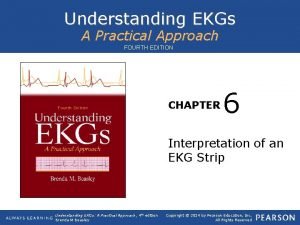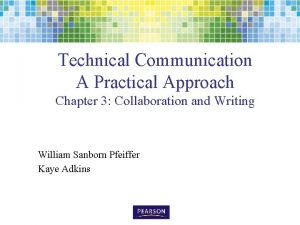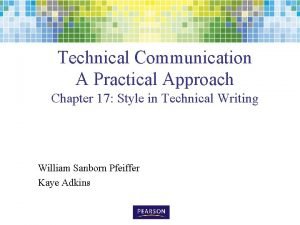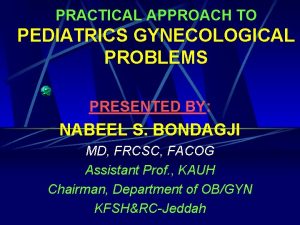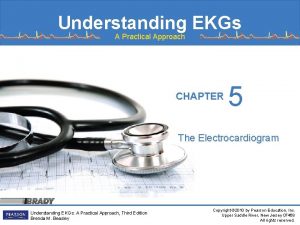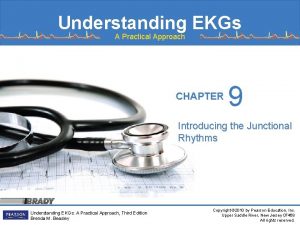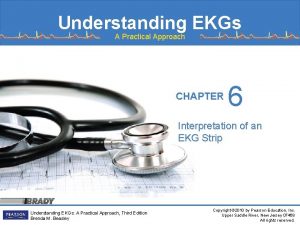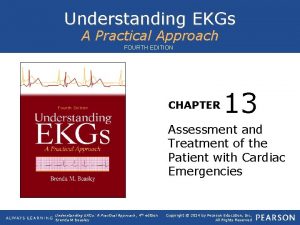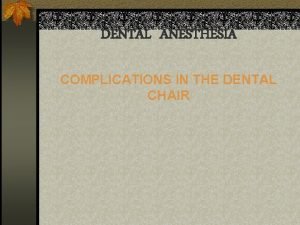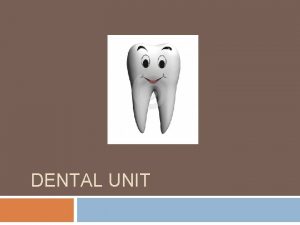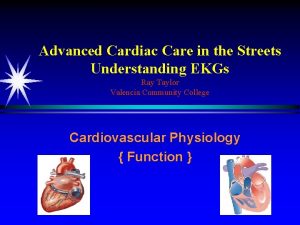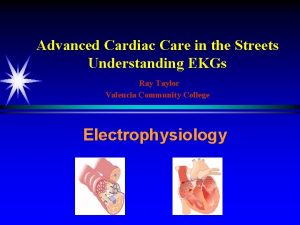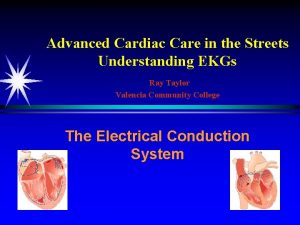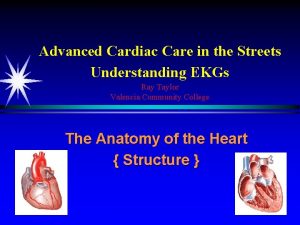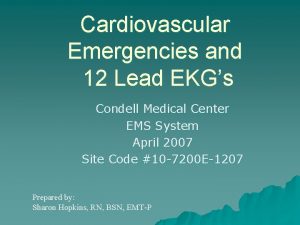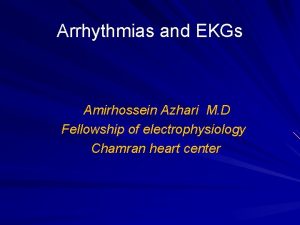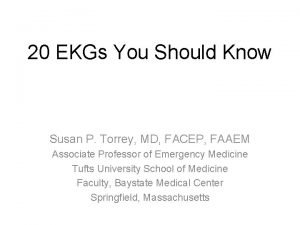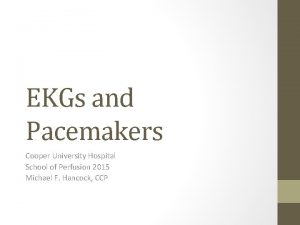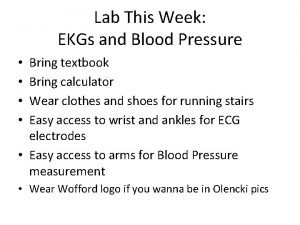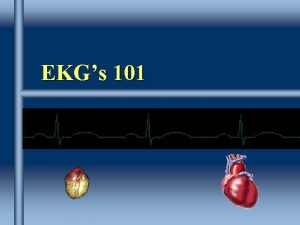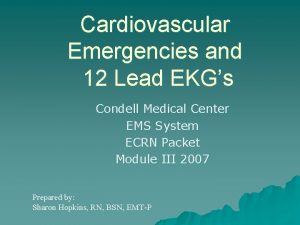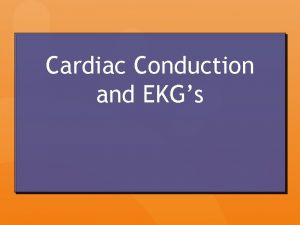Understanding EKGs A Practical Approach For the Dental
























- Slides: 24

Understanding EKGs A Practical Approach For the Dental Hygienist CHAPTER 7 Introducing the Sinus Rhythms Understanding EKGs: A Practical Approach, Third Edition Brenda M. Beasley Copyright © 2010 by Pearson Education, Inc. Upper Saddle River, New Jersey 07458 All rights reserved.

Introducing the Sinus Rhythms • Objectives – Discuss the origin of the sinus rhythms – Identify the components of the electrical conduction system of the heart – Identify a normal sinus rhythm, including EKG characteristics – Describe a sinus bradycardia rhythm, including EKG characteristics Understanding EKGs: A Practical Approach, Third Edition Brenda M. Beasley Copyright © 2010 by Pearson Education, Inc. Upper Saddle River, New Jersey 07458 All rights reserved.

Introducing the Sinus Rhythms • Objectives (continued) – Identify a sinus tachycardia rhythm, including EKG characteristics – Describe a sinus dysrhythmia, including EKG characteristics – Describe a sinus arrest rhythm, including EKG characteristics – Discuss the clinical significance of the sinus rhythms Understanding EKGs: A Practical Approach, Third Edition Brenda M. Beasley Copyright © 2010 by Pearson Education, Inc. Upper Saddle River, New Jersey 07458 All rights reserved.

Blood Flow Again 1. Vena cava 2. R Atrium 3. Tricuspid 4. R Vent 5. Pul Valve 6. Pul art 7. Lungs – gas exchange 8. Pul Vein 9. L Atrium 10. Bicuspid Valve 11. L Vent 12. Aortic valve 13. Aorta 14. Body – gas exchange

Review Terms • • Preload Afterload Stroke Volume Chronotropic Dromotropic Inotropic Neurotransmitters – Sympathetic – Parasympathetic • Alpha • Beta 1 • Beta 2 Understanding EKGs: A Practical Approach, Third Edition Brenda M. Beasley • • • • Cardiac Output Atrioventricular Valves Frank Starling Effect ABCD Contractility Automaticity Excitability Conductivity Electrolytes (4) Polarized State Depolarization Refractory Periods - toilet concept Copyright © 2010 by Pearson Education, Inc. Upper Saddle River, New Jersey 07458 All rights reserved.

Origin of the Sinus Rhythms • The rhythms are classified according to the heart structure in which they begin, or their site of origin • Sinoatrial (SA) node generates impulses at a rate of 60 -100 bpm Understanding EKGs: A Practical Approach, Third Edition Brenda M. Beasley Copyright © 2010 by Pearson Education, Inc. Upper Saddle River, New Jersey 07458 All rights reserved.

Origin of the Sinus Rhythms • This is the inherent or intrinsic rate of the hearts primary pacemaker • Rhythms that originate in SA node are called sinus rhythms Understanding EKGs: A Practical Approach, Third Edition Brenda M. Beasley Copyright © 2010 by Pearson Education, Inc. Upper Saddle River, New Jersey 07458 All rights reserved.

Components of Electrical Conduction System of the Heart • Electrical impulse originates in SA node • Travels through atria via internodal pathways • AV node, brief pause, bundle of His Understanding EKGs: A Practical Approach, Third Edition Brenda M. Beasley Copyright © 2010 by Pearson Education, Inc. Upper Saddle River, New Jersey 07458 All rights reserved.

Components of Electrical Conduction System of the Heart • Right and left bundle branches • Purkinje fibers into the ventricular musculature Understanding EKGs: A Practical Approach, Third Edition Brenda M. Beasley Copyright © 2010 by Pearson Education, Inc. Upper Saddle River, New Jersey 07458 All rights reserved.

Electrical Conduction System of the Heart Add in intra. Atrial pathways Bartender AV Junction Bouncer Understanding EKGs: A Practical Approach, Third Edition Brenda M. Beasley Janitor Copyright © 2010 by Pearson Education, Inc. Upper Saddle River, New Jersey 07458 All rights reserved.

Pacemaker Sites Understanding EKGs: A Practical Approach, Third Edition Brenda M. Beasley Copyright © 2010 by Pearson Education, Inc. Upper Saddle River, New Jersey 07458 All rights reserved.

The Normal Sinus Rhythm • The only “NORMAL” rhythm is normal sinus rhythm (NSR) • All answers in your five-step approach questions must be within normal limits Understanding EKGs: A Practical Approach, Third Edition Brenda M. Beasley Copyright © 2010 by Pearson Education, Inc. Upper Saddle River, New Jersey 07458 All rights reserved.

The Normal Sinus Rhythm • The SA node has generated an impulse that followed the normal pathway of the electrical conduction system Understanding EKGs: A Practical Approach, Third Edition Brenda M. Beasley Copyright © 2010 by Pearson Education, Inc. Upper Saddle River, New Jersey 07458 All rights reserved.

Normal Sinus Rhythm • The heart rate falls within 60 -100 bpm – A variation of 10% is acceptable. • • • Atrial/ventricular rhythms are regular P wave precedes each QRS PR intervals range from 0. 12 -0. 20 seconds QRS complex is less than 0. 12 seconds All five parameters are within normal limits Rhythm is a normal sinus rhythm Understanding EKGs: A Practical Approach, Third Edition Brenda M. Beasley Copyright © 2010 by Pearson Education, Inc. Upper Saddle River, New Jersey 07458 All rights reserved.

Normal Sinus Rhythm Understanding EKGs: A Practical Approach, Third Edition Brenda M. Beasley Copyright © 2010 by Pearson Education, Inc. Upper Saddle River, New Jersey 07458 All rights reserved.

Normal Sinus Rhythms Understanding EKGs: A Practical Approach, Third Edition Brenda M. Beasley Copyright © 2010 by Pearson Education, Inc. Upper Saddle River, New Jersey 07458 All rights reserved.

Sinus Bradycardia Rhythm • Rhythm may resemble a NSR; only difference is the HEART RATE • Brady means SLOW • SA node discharges impulses at rate less than 60 bpm • This one variable makes this an abnormal rhythm Understanding EKGs: A Practical Approach, Third Edition Brenda M. Beasley Copyright © 2010 by Pearson Education, Inc. Upper Saddle River, New Jersey 07458 All rights reserved.

Causes of Sinus Bradycardia • May be caused by intrinsic disease of SA node – Vomiting, hypoxia, hypothermia, electrolyte imbalances or effects of certain drugs (i. e. , digitalis, morphine, beta blockers, calcium channel blockers, etc. ) – May be normal phenomenon, as in wellconditioned athletes or patients who are sleeping Understanding EKGs: A Practical Approach, Third Edition Brenda M. Beasley Copyright © 2010 by Pearson Education, Inc. Upper Saddle River, New Jersey 07458 All rights reserved.

Sinus Bradycardia Understanding EKGs: A Practical Approach, Third Edition Brenda M. Beasley Copyright © 2010 by Pearson Education, Inc. Upper Saddle River, New Jersey 07458 All rights reserved.

Sinus Bradycardia Understanding EKGs: A Practical Approach, Third Edition Brenda M. Beasley Copyright © 2010 by Pearson Education, Inc. Upper Saddle River, New Jersey 07458 All rights reserved.

Sinus Tachycardia Rhythm • Means “fast heart rate” • Sinus – Rhythm originated in SA node – Only difference is the RATE – Rate generally considered between 100 -160 bpm (as high as 200) Understanding EKGs: A Practical Approach, Third Edition Brenda M. Beasley Copyright © 2010 by Pearson Education, Inc. Upper Saddle River, New Jersey 07458 All rights reserved.

Sinus Tachycardia • Causes include exercise, fear, stress, pain, anxiety, and ingestion of stimulants, i. e. , coffee • May result from hypovolemia, CHF, severe dehydration, or acute MI Understanding EKGs: A Practical Approach, Third Edition Brenda M. Beasley Copyright © 2010 by Pearson Education, Inc. Upper Saddle River, New Jersey 07458 All rights reserved.

Sinus Tachycardia Understanding EKGs: A Practical Approach, Third Edition Brenda M. Beasley Copyright © 2010 by Pearson Education, Inc. Upper Saddle River, New Jersey 07458 All rights reserved.

Sinus Tachycardia Understanding EKGs: A Practical Approach, Third Edition Brenda M. Beasley Copyright © 2010 by Pearson Education, Inc. Upper Saddle River, New Jersey 07458 All rights reserved.
 Understanding ekgs a practical approach
Understanding ekgs a practical approach Practical understanding
Practical understanding Technical communication a practical approach
Technical communication a practical approach Technical communication a practical approach
Technical communication a practical approach Practical approach pediatrics
Practical approach pediatrics Culture as a map vs skyscraper
Culture as a map vs skyscraper Ledarskapsteorier
Ledarskapsteorier Offentlig förvaltning
Offentlig förvaltning Datorkunskap för nybörjare
Datorkunskap för nybörjare Fredsgudinna pax
Fredsgudinna pax Steg för steg rita
Steg för steg rita Orubbliga rättigheter
Orubbliga rättigheter Ministerstyre för och nackdelar
Ministerstyre för och nackdelar Vem räknas som jude
Vem räknas som jude Tack för att ni lyssnade bild
Tack för att ni lyssnade bild Claes martinsson
Claes martinsson Sju principer för tillitsbaserad styrning
Sju principer för tillitsbaserad styrning Nyckelkompetenser för livslångt lärande
Nyckelkompetenser för livslångt lärande Ro i rom pax
Ro i rom pax Dikter
Dikter Modell för handledningsprocess
Modell för handledningsprocess Matematisk modellering eksempel
Matematisk modellering eksempel Personalliggare bygg undantag
Personalliggare bygg undantag Verktyg för automatisering av utbetalningar
Verktyg för automatisering av utbetalningar Shaktismen
Shaktismen
